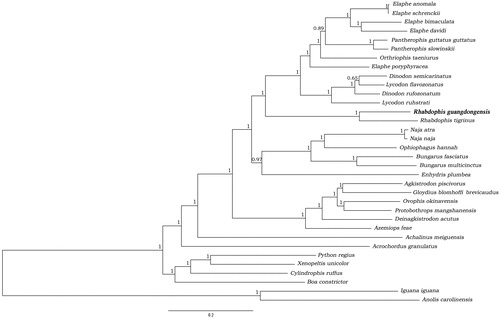Abstract
The complete mitochondrial genome of Rhabdophis guangdongensis is 17,785 bp in length, with a base composition of 38.7% A, 15.9% G, 23.5% C, and 21.9% T. It contains 2 ribosomal RNA(rRNA), 13 protein-coding genes, 22 transfer RNA (tRNA), and 2 control regions, similar to that of other (Colubridae). Twelve concatenated heavy-strand encoded protein-coding genes were used for Bayesian method to construct phylogenetic tree, R. guangdongensis forms a monophyletic group with Rhabdophis tigrinus. This is the first report for the complete mitochondrial genome of R. guangdongensis and it provides the basic data for the taxonomic and phylogenetic of snakes.
Rhabdophis guangdongensis was decribed by Zhu (Zhu et al. Citation2014). Presently, `Genus Rhabdophis, including 22 species, is widely distributed in East Asia and South Asia (http://www.reptile-database.org/). So far, only the complete mitochondria of R. tigrinus have been studied and released (Zhao Citation2016). Here, the complete mitochondrial genome of R. guangdongensis and its phylogenetic relationship were fisrt discussed.
Specimen of R. guangdongensis (SYS r000018, stored in the Museum of Biology, School of Life Sciences, Sun Yat-Sen University) was collected from Danxia Mountain (24°56′16″ N, 113°39′57″ E), Guangdong Province, China and preserved with 95% alcohol. The total genomic DNA was extracted from the muscle using Genomic DNA Extraction Kit (Tiangen, Shanghai, China) according to the instruction. Sixteen pairs of primers were performed to amplify contiguous, overlapping segments covering the complete mitogenome of R. guangdongensis. The mitogenome sequence and protein-coding genes were assembled and analyzed by MEGA 5.0 (Tamura et al. Citation2011). Phylogenetic analysis by BI was carried out using MrBayes 3.1.2 (Huelsenbeck and Ronquist Citation2001).
The full mitochondrial gene length of R. guangdongensis is 17,785bp, which is a circular double-stranded DNA. The genetic composition and sequence are similar to that of most of Colubridae, which have been reported (Peng et al. Citation2016; Zhao et al. Citation2016). Total base composition was 38.7% A, 15.9% G, 23.5% C, and 21.9% T. It consists of 2 rRNA genes (12S and 16S rRNA), 13 protein-coding genes, 22 tRNA genes, and two displacement-loop regions (Dloop1 and Dloop2). Most mitochondrial genes of R. guangdongensis are encoded on the H-strand, in addition to ND6 gene and nine tRNA genes (tRNAGln, tRNAAla, tRNAAsn, tRNACys, tRNATyr, tRNASer (UCN), tRNAGlu, tRNAThr, and tRNAPro) are encoded on the L-strand. Among the 13 protein-coding genes, none of these genes have introns and some overlap with other genes, overlapping 10bp between ATP6 and ATP8, ATP6 and COXIII overlap for 1bp, and ND4L overlap for 1bp with ND4. The sequence length of 12S rRNA is 927 bp and 16S rRNA sequence length is 1468 bp. Both of them are located between the tRNAPhe and ND1 genes and are separated by the tRNAVal, which is located in the same position as other snakes. R. guangdongensis has two control regions, Dloop1 is located between tRNAPro and tRNAphe genes and is 1575 bp in length, Dloop2 is located between tRNAIle and tRNALeu (UUR) genes and is 1076 bp in length.
The aligned 12 heavy-chain protein coding genes with a total length of 10,286 bp are used to reconstruct the phylogenetic tree (). Most branching structures were forcefully supported with 1.0 Bayesian posterior probability (PP). The result showed that R. tigrinus and R. guangdongensis form a sister relationship at the base of the monophyletic system (PP = 1). Similar results showed previous studies (Figueroa et al. Citation2016; Takeuchi et al. Citation2018). This study first revealed the complete mitochondrial genome of R. guangdongensis, which can contribute to the research and conservation of this important and rare wild snake.
Acknowledgements
We thank Professor Yingyong Wang for his assistance in sample collection.
Disclosure statement
The authors declare that they have no competing interests. The authors alone are responsible for writing of this paper.
Additional information
Funding
References
- Figueroa A, Mckelvy AD, Grismer LL, et al. 2016. A species-level phylogeny of extant snakes with description of a new colubrid subfamily and genus. PLoS One. 11:e0161070.
- Huelsenbeck JP, Ronquist F. 2001. MRBAYES: Bayesian inference of phylogenetic trees. Bioinformatics. 17:754–755.
- Peng LF, Weng SY, Yang DC, Lu CH, Huang S. 2016. Complete mitochondrial genome of the Xianggelila Hot-spring snake, Thermophis shangrila (Reptilia, Colubridae). Mitochondrial DNA B Resour. 1:536–537.
- Tamura K, Peterson D, Peterson N, Stecher G, Nei M, Kumar S. 2011. MEGA5: molecular evolutionary genetics analysis using maximum likelihood, evolutionary distance, and maximum parsimony methods. Mol Biol Evol. 28:2731–2739.
- Takeuchi H, Savitzky AH, Ding L, de Silva A, Das I, Nguyen TT, Tsai T-S, Jono T, Zhu G-X, Mahaulpatha D, et al. 2018. Evolution of nuchal glands, unusual defensive organs of Asian natricine snakes (Serpentes: Colubridae), inferred from a molecular phylogeny. Ecol Evol. 8:10219–10232.
- Zhao D, Liu H, Zhao W-G, Liu P. 2016. The complete mitochondrial DNA sequence and the phylogenetic position of Rhabdophis tigrinus (Reptilia: Squamata). Mitochondrial DNA B Resour. 1:216–217.
- Zhu G-X, Wang Y-Y, Takeuchi H, Zhao E-M. 2014. A new species of the genus Rhabdophis Fitzinger, 1843 (Squamata: Colubridae) from Guangdong Province, southern China. Zootaxa. 3765:469–480.

